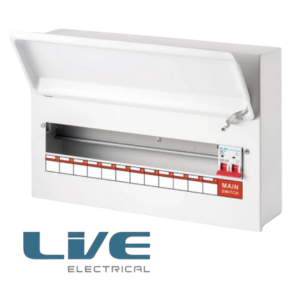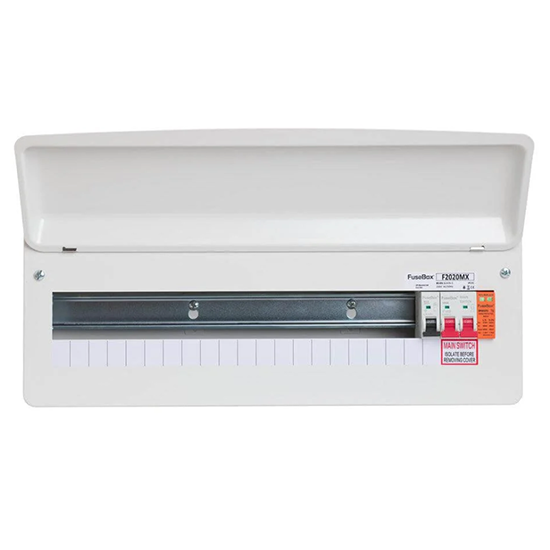How RCBO CONSUMER UNITS Enhance Electrical Safety in Residential Spaces
How RCBO CONSUMER UNITS Enhance Electrical Safety in Residential Spaces
Blog Article
The Function of Consumer Devices in Effective Power Monitoring Solution
Customer units are integral to efficient power management systems, working as the key distribution points for electrical power within structures. By integrating circuit breakers, they protect circuits from prospective overloads, hence maintaining security and preventing considerable failures. The development of smart modern technologies has actually additionally improved their performance, permitting real-time information surveillance and nuanced power intake evaluation. This assimilation not only enhances energy usage but likewise facilitates the incorporation of renewable energy resources, thus promoting lasting methods. Just how, then, do these innovations convert to concrete benefits in daily energy administration?
Recognizing Consumer Devices

Comprehending the duty of customer systems starts with recognizing their essential feature in protecting electric systems. By isolating mistakes within specific circuits, consumer devices stop prevalent interruptions and possible fire hazards. This seclusion is accomplished with the usage of breaker that trip or integrates that impact when a mistake is spotted, therefore reducing off the electric flow to the impacted circuit.
Furthermore, customer devices promote the orderly distribution of power, enhancing the performance of energy use. They permit for the systematic monitoring of electric loads, which can be specifically essential in business and industrial setups where demand can rise and fall significantly. Effectively maintained customer units add to the durability of electric systems and help in lessening downtime triggered by electric failures, eventually sustaining the smooth operation of energy-dependent facilities.
Smart Technologies Assimilation

A key advantage of wise consumer systems is their ability to take advantage of advanced algorithms and artificial intelligence for anticipating analytics. This permits for preemptive changes based upon usage patterns, weather prediction, and other variables, significantly enhancing general efficiency. Smart consumer systems promote demand response programs, where energy use can be dynamically adjusted during top periods to stabilize the grid and lower expenses.
The integration of renewable energy resources, such as solar and wind, is additionally streamlined via smart customer devices. By intelligently taking care of the intermittency of these resources, these units guarantee a trusted and well balanced power supply. Furthermore, smart customer units improve individual engagement by giving detailed insights and remote control capabilities with mobile applications, cultivating a more aggressive method to power conservation and sustainability.
Surveillance Energy Usage
Building on the capacities of smart innovations assimilation, keeping an eye on power intake ends up being a vital focus within energy management systems. Reliable tracking functions as the foundation for determining power inefficiencies and applying corrective actions. By leveraging sophisticated metering facilities (AMI), real-time data on power use can be gathered at granular levels, offering valuable insights right into intake patterns and peak demand durations. This data-centric method allows both customers and power supervisors to make enlightened choices targeted at decreasing image source waste and improving total effectiveness.
Smart meters and Web of Things (IoT) gadgets play an essential role in this tracking process. These gadgets can track energy use in real-time, sending data to centralized systems for analysis. The gathered information is after that refined through advanced algorithms to find abnormalities, anticipate future usage, and suggest optimization methods. In addition, cloud-based solutions supply scalable platforms for saving and assessing huge datasets, assisting in remote monitoring and control.
The combination of these technologies not only empowers customers with in-depth details concerning their power usage however additionally supports energy carriers in handling load distribution better. Inevitably, specific and continual tracking is essential for accomplishing energy efficiency, price financial savings, and sustainability goals within energy monitoring systems.
Optimizing Device Usage

One efficient method involves identifying top and off-peak hours to change energy-intensive activities, such as laundry or dishwashing, to times when energy demand is lower. This not only decreases strain on the grid yet also takes advantage of reduced energy tolls. In addition, incorporating maker understanding algorithms permits for anticipating maintenance, guaranteeing appliances run at optimal effectiveness and lengthening their life expectancy.
Energy management systems can likewise incorporate user-specific preferences and behaviors to customize device use timetables. Smart lighting systems can change brightness based on occupancy and natural light accessibility, while HVAC systems can preserve comfort degrees without excessive energy use.
Supporting Sustainability
Advertising sustainability within energy monitoring systems involves not only improving effectiveness yet also cultivating environmentally accountable practices. Customer units are integral to this procedure, as they give real-time information and control mechanisms that enable customers to keep an eye on and minimize their energy consumption. By leveraging sophisticated modern technologies, customer devices can determine energy-saving possibilities and facilitate the combination of renewable power resources like solar and wind power.
One crucial element useful content of advertising sustainability is informing customers on the advantages of liable energy usage. Through detailed insights offered by consumer systems, individuals can make educated choices that minimize their carbon footprint. These units can suggest optimal times for running high-energy home appliances based on grid need and renewable energy availability, therefore lowering dependence on fossil fuels.
In addition, consumer systems support the fostering of smart grid innovations, which boost the general performance and dependability of energy distribution. By enabling two-way communication in between consumers and utility service providers, these systems can dynamically adapt to energy needs, lowering waste and advertising the use of lasting energy techniques.
Conclusion
Consumer systems, as essential components of power administration systems, considerably improve electrical security and efficiency within structures via circuit defense and smart modern technology integration. In addition, the unification of eco-friendly energy resources advertises lasting practices, adding to reduced total energy consumption and lower carbon footprints.
Advances in clever modern technologies have actually changed the capacities of energy monitoring systems, specifically with the assimilation of wise consumer units.Building on the capacities of wise modern technologies integration, keeping track of power usage becomes a critical emphasis within energy administration systems.Reliable device use optimization is a critical part of energy administration systems, aiming to improve performance and lower unnecessary power consumption.Customer units, as essential parts of energy management systems, significantly Get More Information improve electric safety and security and performance within buildings through circuit defense and clever technology integration. Additionally, the consolidation of eco-friendly power resources advertises sustainable techniques, adding to minimized total power usage and lower carbon impacts.
Report this page